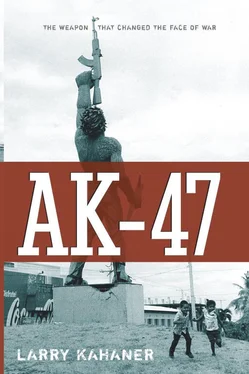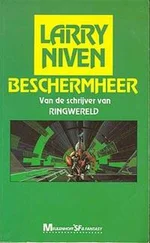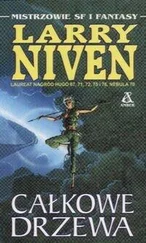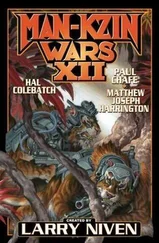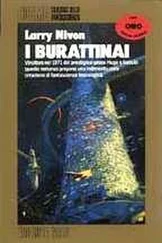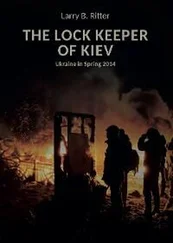Larry Kahaner - AK-47
Здесь есть возможность читать онлайн «Larry Kahaner - AK-47» весь текст электронной книги совершенно бесплатно (целиком полную версию без сокращений). В некоторых случаях можно слушать аудио, скачать через торрент в формате fb2 и присутствует краткое содержание. Город: Hoboken, Год выпуска: 2007, ISBN: 2007, Издательство: John Wiley & Sons, Inc., Жанр: История, military_history, на английском языке. Описание произведения, (предисловие) а так же отзывы посетителей доступны на портале библиотеки ЛибКат.
- Название:AK-47
- Автор:
- Издательство:John Wiley & Sons, Inc.
- Жанр:
- Год:2007
- Город:Hoboken
- ISBN:9780470315668
- Рейтинг книги:3 / 5. Голосов: 1
-
Избранное:Добавить в избранное
- Отзывы:
-
Ваша оценка:
- 60
- 1
- 2
- 3
- 4
- 5
AK-47: краткое содержание, описание и аннотация
Предлагаем к чтению аннотацию, описание, краткое содержание или предисловие (зависит от того, что написал сам автор книги «AK-47»). Если вы не нашли необходимую информацию о книге — напишите в комментариях, мы постараемся отыскать её.
AK-47 — читать онлайн бесплатно полную книгу (весь текст) целиком
Ниже представлен текст книги, разбитый по страницам. Система сохранения места последней прочитанной страницы, позволяет с удобством читать онлайн бесплатно книгу «AK-47», без необходимости каждый раз заново искать на чём Вы остановились. Поставьте закладку, и сможете в любой момент перейти на страницу, на которой закончили чтение.
Интервал:
Закладка:
At the official launch at London’s Century Club, Kalashnikov stayed on message, too. In Russian, he said to the crowd, “I would like the product we are about to launch to be as reliable and easy to use as my gun.” It would be a message that he would repeat on many other occasions.
The reception included samples served to the crowd by Natasha, Anoushka, and Ivana, models clad in white, military-type uniforms and short skirts and known as the “Nikita Girls.” Their role was to visit bars during promotional efforts to push the Kalashnikov brand.
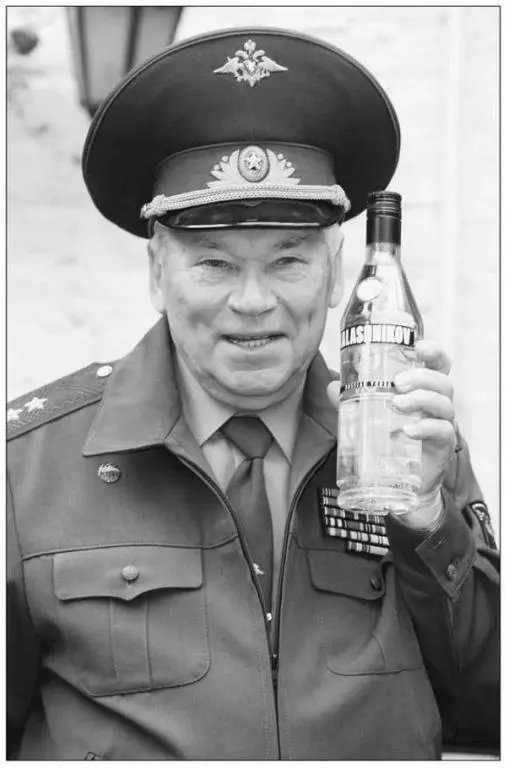
In interviews after the reception, Kalashnikov said, “I am to blame only for having designed a reliable weapon…. I am very sad when I see my weapon being used when they shouldn’t be used, but the designer is not to blame. It’s the politicians who are to blame.” Like a good soldier, he also stuck with his commercial message during public appearances touting the new brew. “I’ve always wanted to improve and expand on the good name of my weapon by doing good things,” he said. “So we decided to create a vodka under my name, and we wanted that vodka to be better than anything made up until now in both Russia and England.”
In less public moments, however, he expressed his resigned reluctance at becoming a shill, saying, “What can you do? These are our times now.” As he had been for most of his later life, Kalashnikov found himself torn between the capitalist reality of making money in the New Russia and holding firm to his lifelong Communist belief that what matters is doing your duty for the motherland without any thought of financial compensation.
Propelled by Florey’s skill and Kalashnikov’s notoriety, the vodka juggernaut was on a tear. Hip magazines like FHM placed it among the top ten best vodkas in their staff taste tests. Talk Loud PR, a public relations firm that had worked on the Polstar Vodka account, convinced bartenders to create trendy drinks using the vodka and submitted them to magazines. The London Sunday Times Style magazine displayed a picture of actress Julia Roberts with the caption reporting her interest in a drink called a Scorpino that contained Kalashnikov Vodka. The soft-porn men’s magazine ICE featured an irreverent Q&A with Kalashnikov along with a pictorial titled “Raise Your Glass the Ruskie Way,” on how to drink vodka in the traditional Russian style.
The initial $90,000 public relations blitz was paying off. The company was on the way to its goal of selling forty-four thousand cases by 2006 to bars and restaurants before targeting the retail trade. Florey even hoped to place a new phrase into the English drinking lexicon: “I went out last night and got Kalashed.”
Then a problem arose.
Alcohol Focus Scotland, a group dedicated to “changing Scotland’s drinking culture,” complained to the Portman Group, a regulatory body funded by the drinks industry. It claimed that Kalashnikov Vodka “suggested an association with bravado, or with violent, aggressive, dangerous or anti-social behavior,” and therefore violated the group’s code of practice.
Complaints of this nature were fairly common as drink makers pushed the envelope as far as they could to create interest in their products, especially among younger consumers. For instance, during the time that the Portman Group was deliberating possible action against Kalashnikov Vodka, it was considering other breaches including whether a line of “tube drinks” named Blow Job, Orgasm, Foreplay, and Bit on the Side violated regulations because they implied a connection between alcohol use and sexual behavior, a group no-no. Another complaint at the time was that a pair of vodka drinks named Rocket Fuel Vodka and Rocket Fuel Ice, in concert with their prominent positioning of their very high alcohol content, 42.85 percent, were clearly using the intoxicating effect to sell themselves, another breach of the code. Both were found to be violations.
Of the more than 140 complaints dating back to 1996 (the group was started in 1989), the vast majority of upheld complaints concerned blatant sexual content in labels or packaging or false and misleading labels. Until Kalashnikov Vodka came along, only two actions had been taken against companies for violent content: a beer named Heist (even though the group conceded that it was American slang for a robbery), and a product named TNT Liquid Dynamite designed to represent a stick of dynamite with a fuse in it.
Florey argued that the Kalashnikov brand was based on “comradeship” and not military imagery. Company officials admitted that the brand was “funky” and “in your face,” but that it “didn’t cause people to take up armed conflict.”
Florey put Kalashnikov out front to help spin public opinion their way. He gave interviews saying that it was wrong to associate the AK with aggression. Wearing an AK tie clip, Kalashnikov told Financial Times reporters, “The gun serves peace and friendship because it is used to defend one’s country. Look how many countries have been liberated using this gun.”
His arguments did not persuade the Portman Group, and they found that Kalashnikov Vodka violated the industry’s own rules.
The group’s assessment was both good and bad news for Florey and Kalashnikov. Although the Portman Group upheld the complaint, it officially recognized the pop icon status of the AK to the Western world. Even though the vodka’s packaging did not look like an AK or contain any violent or antisocial references, the Kalashnikov name alone was enough to provoke a passionate response in the hearts of consumers. To marketers, this was a good thing. The panel said in its January 21, 2005, report, “Having considered the product as a whole, including its packaging and overall presentation, the Panel concluded that a name that primarily evoked an image of a contemporary gun, namely the AK, which was one of, if not the most widely used firearm in the world, was an unacceptable choice of brand name for an alcoholic drink, because it indirectly suggested an association with violent and dangerous behavior.”
In true entrepreneurial flip style, Florey told those around him that any publicity was good publicity. At the same time, however, he took Portman to task publicly, complaining that other alcoholic beverages were named for weapons, including Spitfire beer, Bombardier beer, and Claymore scotch, and they had not been banned.
Florey had no choice but to begin negotiations with the panel to find a solution, which probably would mean changing the name in the United Kingdom. The company could still keep it for export. In fact, the vodka was doing extremely well in the Middle East. “There’s an affinity in the Middle East with the gun,” Florey noted. “And we’re setting up a franchise in South Africa called ‘AK-47 Freedom Vodka.’”
With negotiations going nowhere and bottles banned from shelves, the situation was looking grim until a journalist at a Portman-held news conference—convened to explain its decision—suggested a name that Portman chairman Sir Paul Condon admitted would probably work. By fall 2005, “General Kalashnikov Russian Vodka” was slated for a comeback in England and a push toward North America.
ALTHOUGH MANY PEOPLE (like the Portman Group) considered exploiting a deadly weapon for financial gain in bad taste, even more bizarre examples began to crop up. No longer only part of the military, counterculture, or Middle Eastern “Kalashnikov Culture,” the AK was being seen and mentioned almost daily in mainstream movies, books, and on TV. What once was a horrible but everyday item in some parts of the world was now a solid part of contemporary global culture.
Читать дальшеИнтервал:
Закладка:
Похожие книги на «AK-47»
Представляем Вашему вниманию похожие книги на «AK-47» списком для выбора. Мы отобрали схожую по названию и смыслу литературу в надежде предоставить читателям больше вариантов отыскать новые, интересные, ещё непрочитанные произведения.
Обсуждение, отзывы о книге «AK-47» и просто собственные мнения читателей. Оставьте ваши комментарии, напишите, что Вы думаете о произведении, его смысле или главных героях. Укажите что конкретно понравилось, а что нет, и почему Вы так считаете.
